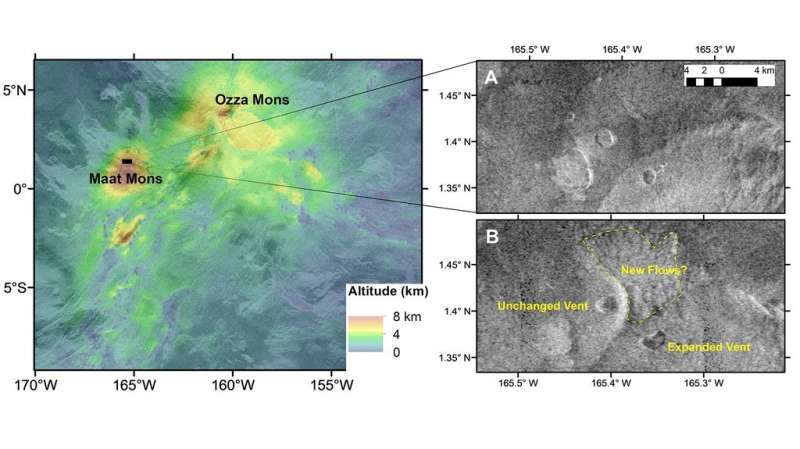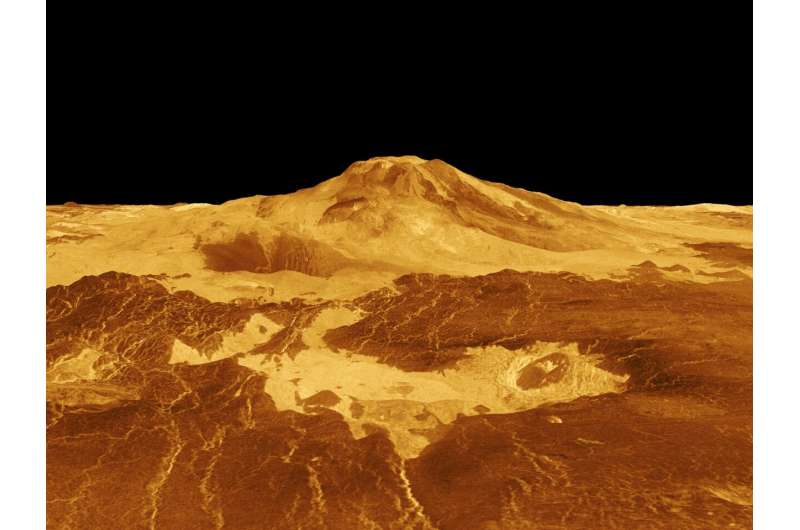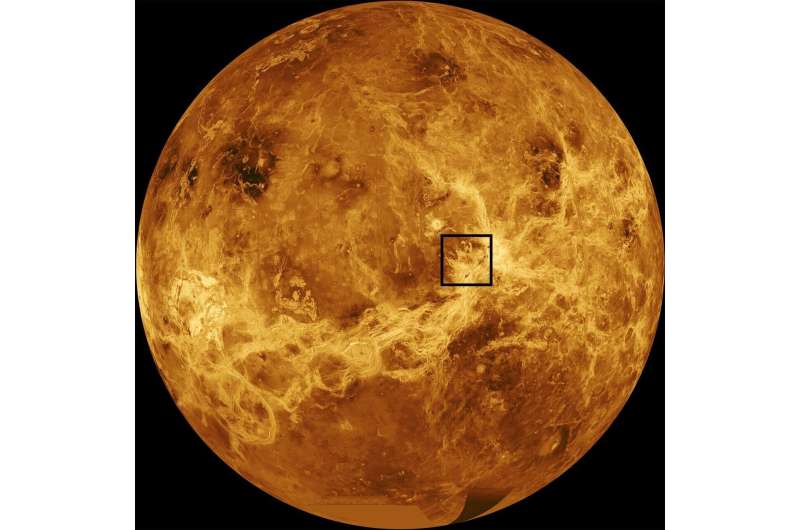Venus appears to have volcanic activity, according to a new research paper that offers strong evidence to answer the lingering question about whether Earth’s sister planet currently has eruptions and lava flows.
Venus, although similar to Earth in size and mass, differs markedly in that it does not have plate tectonics. The boundaries of Earth’s moving surface plates are the primary locations of volcanic activity.
New research by University of Alaska Fairbanks Geophysical Institute research professor Robert Herrick revealed a nearly 1-square-mile volcanic vent that changed in shape and grew over eight months in 1991. Changes on such a scale on Earth are associated with volcanic activity, whether through an eruption at the vent or movement of magma beneath the vent that causes the vent walls to collapse and the vent to expand.
The research was published today (March 15) in the journal Science.
Herrick studied images taken in the early 1990s during the first two imaging cycles of NASA’s Magellan space probe. Until recently, comparing digital images to find new lava flows took too much time, the paper notes. As a result, few scientists have searched Magellan data for feature formation.
“It is really only in the last decade or so that the Magellan data has been available at full resolution, mosaicked and easily manipulable by an investigator with a typical personal workstation,” Herrick said.

Altitude data for the Maat and Ozza Mons region on the Venus surface is shown at left, with the area of study indicated by the black box. At right are the before (A) and after (B) Magellan observations of the expanded vent on Maat Mons, with possible new lava flows after an eruptive event. Credit: Robert Herrick/UAF
The new research focused on an area containing two of Venus’ largest volcanoes, Ozza and Maat Mons.
“Ozza and Maat Mons are comparable in volume to Earth’s largest volcanoes but have lower slopes and thus are more spread out,” Herrick said.
Maat Mons contains the expanded vent that indicates volcanic activity.
Herrick compared a Magellan image from mid-February 1991 with a mid-October 1991 image and noticed a change to a vent on the north side of a domed shield volcano that is part of the Maat Mons volcano.
The vent had grown from a circular formation of just under 1 square mile to an irregular shape of about 1.5 square miles.
The later image indicates that the vent’s walls became shorter, perhaps only a few hundred feet high, and that the vent was nearly filled to its rim. The researchers speculate that a lava lake formed in the vent during the eight months between the images, though whether the contents were liquid or cooled and solidified isn’t known.

Maat Mons is displayed in this computer generated three-dimensional perspective of the surface of Venus. The viewpoint is located 634 kilometers (393 miles) north of Maat Mons at an elevation of 3 kilometers (2 miles) above the terrain. Lava flows extend for hundreds of kilometers across the fractured plains shown in the foreground, to the base of Maat Mons. The view is to the south with the volcano Maat Mons appearing at the center of the image on the horizon and rising to almost 5 kilometers (3 miles) above the surrounding terrain. Maat Mons is located at approximately 0.9 degrees north latitude, 194.5 degrees east longitude with a peak that ascends to 8 kilometers (5 miles) above the mean surface. Maat Mons is named for an Egyptian Goddess of truth and justice. Magellan synthetic aperture radar data is combined with radar altimetry to develop a three-dimensional map of the surface. The vertical scale in this perspective has been exaggerated 10 times. Rays cast in a computer intersect the surface to crate a three-dimensional perspective view. Simulated color and a digital elevation map developed by the U.S. Geological Survey are used to enhance small-scale structure. The simulated hues are based on color images recorded by the Soviet Venera 13 and 14 spacecraft. The image was produced by the Solar System Visualization project and the Magellan Science team at the JPL Multimission Image Processing Laboratory and is a single frame from a video released at the April 22, 1992 news conference. Credit: NASA/JPL
The researchers offer one caveat: a nonvolcanic, earthquake-triggered collapse of the vent’s walls might have caused the expansion. They note, however, that vent collapses of this scale on Earth’s volcanoes have always been accompanied by nearby volcanic eruptions; magma withdraws from beneath the vent because it is going somewhere else.
The surface of Venus is geologically young, especially compared to all the other rocky bodies except Earth and Jupiter’s moon Io, Herrick said.
“However, the estimates of how often eruptions might occur on Venus have been speculative, ranging from several large eruptions per year to one such eruption every several or even tens of years,” he said.
Herrick contrasts the lack of information about Venusian volcanism with what is known about Jupiter’s moon Io and about Mars.
“Io is so active that multiple ongoing eruptions have been imaged every time we’ve observed it,” he said.
On a geological time scale, relatively young lava flows indicate Mars remains volcanically active, Herrick said.

This annotated, computer-simulated global map of Venus’ surface is assembled from data from NASA’s Magellan and Pioneer Venus Orbiter missions. Maat Mons, the volcano that has exhibited signs of a recent eruption, is within the black square near the planet’s equator. Credit: NASA/JPL-Caltech
“However, nothing has occurred in the 45 years that we have been observing Mars, and most scientists would say that you’d probably need to watch the surface for a few million years to have a reasonable chance of seeing a new lava flow,” he said.
Herrick’s research adds Venus to the small pool of volcanically active bodies in our solar system.
“We can now say that Venus is presently volcanically active in the sense that there are at least a few eruptions per year,” he said. “We can expect that the upcoming Venus missions will observe new volcanic flows that have occurred since the Magellan mission ended three decades ago, and we should see some activity occurring while the two upcoming orbital missions are collecting images.”
Co-author Scott Hensley of NASA’s Jet Propulsion Laboratory performed the modeling for the research.
Source: phys.org







